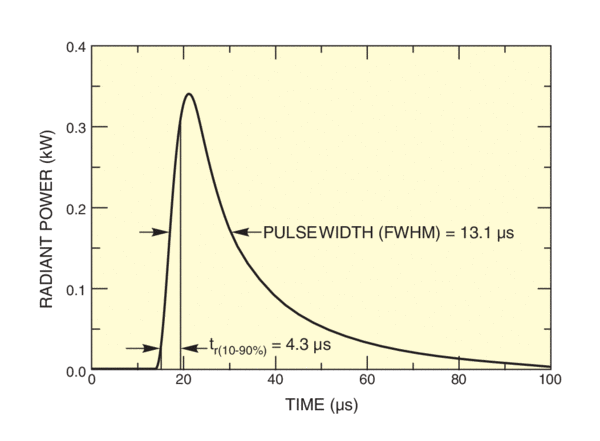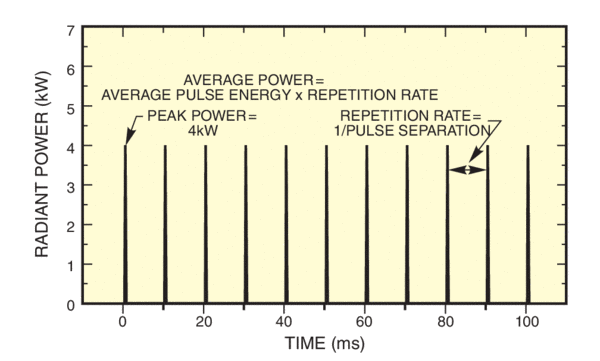Φe(λ,t) represents the flux per unit wavelength at wavelength λ and time t; Φe(t) represents the total flux (for all wavelengths), at time t. Φe(λ) is the spectral distribution of radiant energy, while Qe represents the total energy for all wavelengths.
For Φe(t) in Watts, Qe will be in joules.
Δt, is the time interval for the integration that encompasses the entire pulse, but in practice it should be restricted to exclude any low level continuous background or other pulses.
The pulse is characterized by a pulsewidth. There is no established definition for pulsewidth. Often, but not always, it means halfwidth, full width at half maximum (FWHM). For convenience average pulse power is often taken as the pulse energy divided by the pulsewidth. The validity of this approximation depends on the pulse shape. It is exact for a “top hat” pulse where the average power and peak power are the same. For the flashlamp pulse shown in Fig.1, the pulse energy, obtained by integrating, is 6.7 mJ, the pulse width is 13.1 µs, so the “average power” computed as above is 0.51 kW. The true peak power is 0.34 kW and thus a nominal inconsistency due to arbitrary definition of pulse width.
Figure 2 shows a train of pulses, similar to the pulse in Fig. 1. Full characterization requires knowledge of all the parameters of the single pulse and the pulse repetition rate. The peak power remains the same, but now the average power is the single pulse energy multiplied by the pulse rate in Hz.
When recording pulses you should ensure that the detector and its associated electronics are fast enough to follow the true pulse shape. As a rule of thumb, the detection system bandwidth must be wider than 1/(3tr) to track the fast risetime, tr, to within 10% of actual. A slow detector system shows a similar pulse shape to that in Fig.1, but the rise and fall times are, in this case, characteristic of the detector and its electronic circuitry. If you use an oscilloscope to monitor a pulse you will probably need to use a “termination” to reduce the RC time constant of the detection circuitry and prevent electrical signal reflections within a coaxial cable. For example, an RG 58/U coaxial cable requires a 50 ohm termination.
 Over 8,000 products in-stock! & FREE 2-Day shipping on all web orders!* Learn More FREE T-Shirt with orders $250+ Details
Over 8,000 products in-stock! & FREE 2-Day shipping on all web orders!* Learn More FREE T-Shirt with orders $250+ Details


 Ultra-High Velocity
Ultra-High Velocity